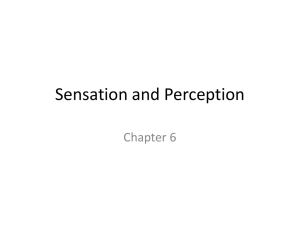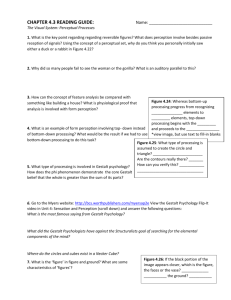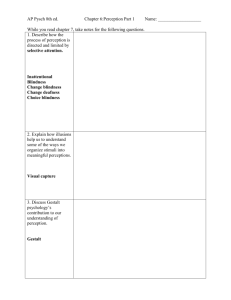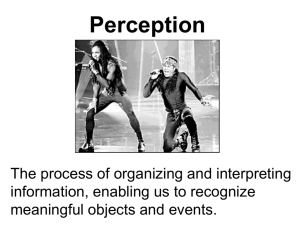Some Perceptual Illusions
advertisement
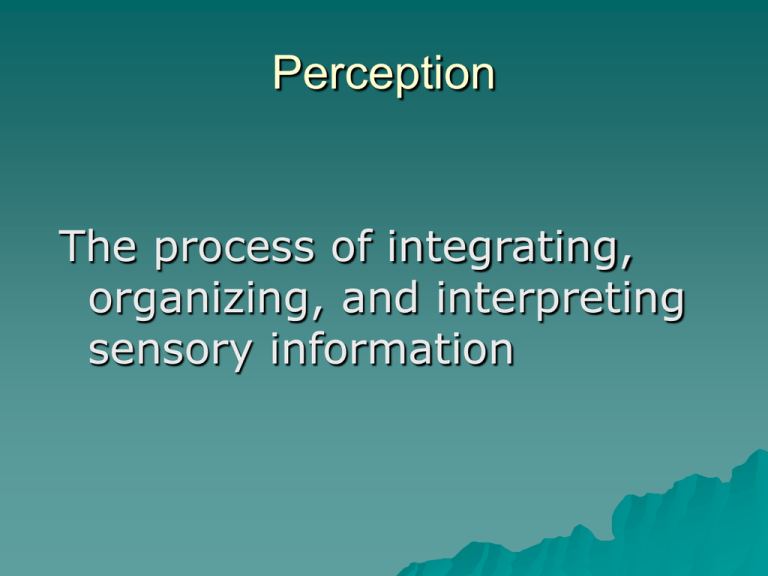
Perception The process of integrating, organizing, and interpreting sensory information Perceptual Processing Bottom-up processing—emphasizes the importance of sensory receptors in detecting the basic features of a stimulus. Moves from part to whole. Also called data-driven processing. Top-down processing—emphasizes importance of observer’s cognitive processes in arriving at meaningful perceptions. Moves from whole to part. Also called conceptually driven processing. Perceptual Organization Some of the best examples of perceptual organization were provided by the Gestalt psychologists Gestalt psychologists hypothesized that “the whole is greater than the sum of the parts” They were interested in showing the global nature of our perceptions Figure and Ground Gestalt Psychologists also thought that an important part of our perception was the organization of a scene in to its: Figure—the object of interest Ground —the background Gestalt Grouping Principles Gestalt theorists argued that our perceptual systems automatically organized sensory input based on certain rules Proximity Similarity Closure Good Continuation Common Movement Good Form Depth Perception One of our more important perceptual abilities involves seeing in three-dimensions Depth perception is difficult because we only have access to twodimensional images How do we see a 3-D world using only the 2-D retinal images? Depth Perception Cues Cue—stimulus characteristics that influence our perceptions We are able to see in 3-D because the visual system can utilize depth cues that appear in the retinal images Types of Depth Cues Depth cues are usually divided into categories, we will consider two types of depth cues: Monocular—depth cues that appear in the image in either the left or right eye Binocular—depth cues that involve comparing the left and right eye images Monocular Depth Cues Relative image size Linear perspective Texture gradient Overlap Aerial perspective Motion parallax Binocular Depth Cues Our best depth perception occurs if we look through both eyes This is because our right and left eyes see a slightly different view of the world this is called binocular disparity Convergence is the degree to which your eye muscles must rotate to see an object. Stereogram Another way to create the illusion of depth through binocular with a stereogram A stereogram is formed by superimposing two repeating patterns The two patterns are slightly offset; when viewed properly, this offset is seen as a binocular disparity Stereogram Perception of Motion Process that is not very well understood Usually assume that the figure is moving and the ground is stationary Stroboscopic motion--perception of motion caused by carefully timed flashing lights PhiPhenomenon Apparent motion Perceptual Constancy When viewing conditions change, the retinal image changes even if the objects being viewed remain constant Example: as a person walks away from you, their retinal image decreases in size Important function of the perceptual system is to represent constancy in our environment even when the retinal image varies Size Constancy Cylinders at positions A and B are the same size even though their image sizes differ The depth cues such as linear perspective and texture help the visual system judge the size accurately Point B Point A Shape Constancy It is hard to tell if the figure on the upper right is a trapezoid or a square slanted backward If we add texture, the texture gradient helps us see that it is actually a square Perceptual Completion Some Perceptual Illusions Relationship Between Perceived Size and Perceived Depth To perceive the size of objects accurately we must also perceive their distance accurately Thus, many visual illusions occur simply because a particular image lacks sufficient depth cues Retina Image Image Pupil A B A This figure shows that image size depends upon both object size and distance Ames Room The Ames room is designed so that the monocular depth cues give the illusion that the two people are equally far away Müller-Lyer Illusion Ponzo Illusion Converging lines indicate that top line is farther away than bottom line

